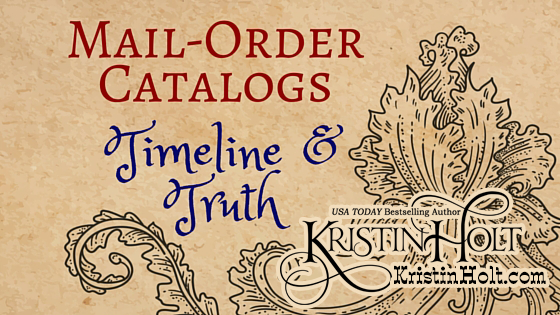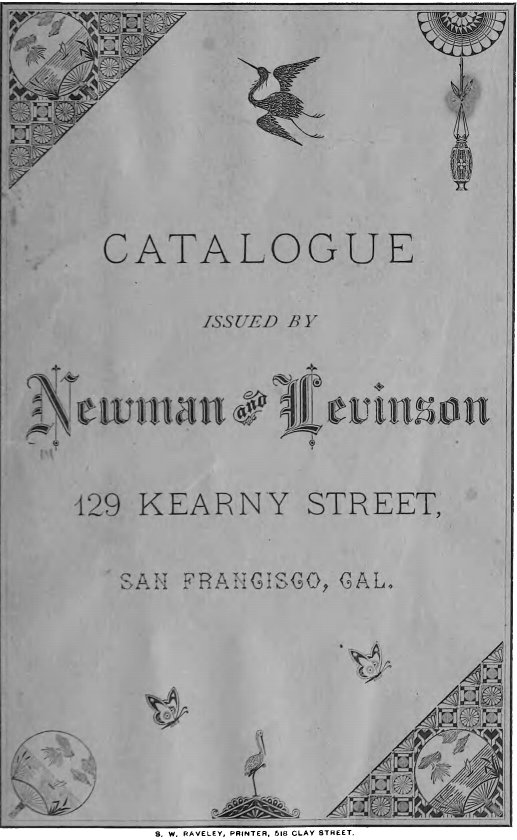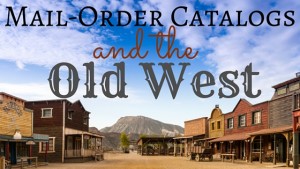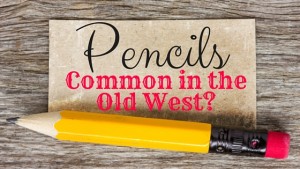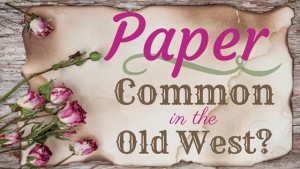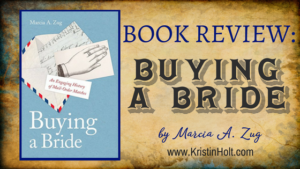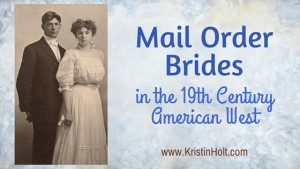Mail-Order Catalogs: Timeline and Truth
Mail-Order Catalogs: Timeline and Truth
.
![]()
.
Mail-order catalogs didn’t show up in America as early as you might think.
Thus mail-order shopping couldn’t have impacted the mail-order bride phenomenon as early as today’s popular fiction market suggests.
.
![]()
.
Catalogue vs Advertisements
.
Plenty of advertisement catalogues for various merchants have survived til today. These examples of nineteenth century marketing promote clothing fashions of the day for men, women, and children. Booklets encourage shoppers to visit and make purchases. These examples are intriguing in many ways. As they don’t contain references to mail-order sales. I’ll leave this category of “catalogue” for another time.
.
Timeline:
.
1845: Tiffany & Co. publishes and distributes the first United States mail-order Catalog, known as the “Blue Book”. (After all, “Tiffany Blue” had to come from somewhere.) See an 1878 Tiffany & Co. catalogue.
.
1872: Montgomery Ward’s first mail-order catalogue debuted in 1872–a single sheet (8×12-inches) that listed more than 150 items.
.
1877: O. Jones’ Catalogue shipped purchases all over the western hemisphere. Their many-storied department store stood in New York City. [Note: this catalogue is dated 1877; O. Jones may have begun catalogue mail-order sales before this date.]
.
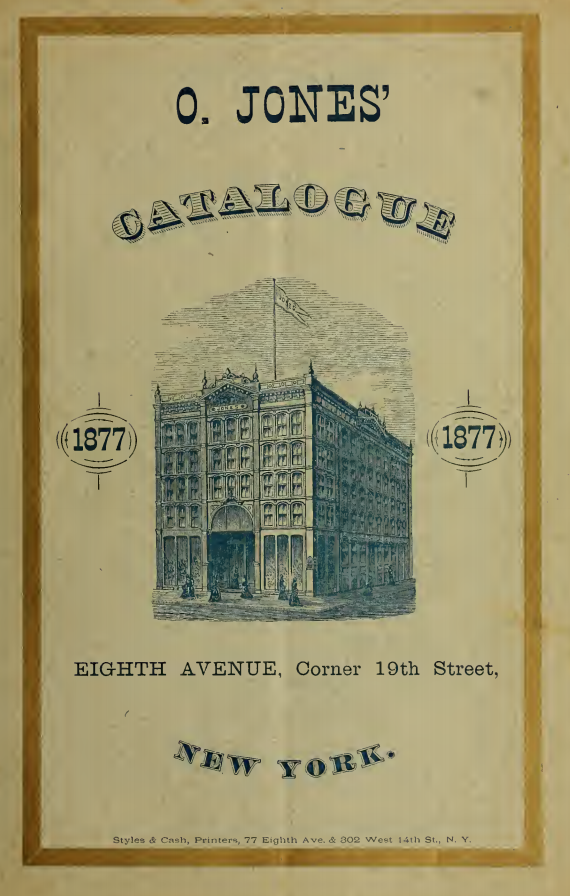
1877 O. Jones’ Catalogue title page. Address: Eighth Avenue, corner 19th Street, New York. Following page reads “Goods sent to all parts of the United States and Territories, Canada, South and Central America, and the West Indies. Terms– Strictly C.O.D., unless prepaid by draft or P.O. Order, which in each case should be payable in this city (New York) to the order of O. Jones.”
.
1878: Catalogue of Novelties and Specialties in Ladies’ and Children’s Underwear, constructed on Dress Reform and Hygienic Principles. Manufactured by George Frost & Co., Devonshire St., Boston. [Note: this catalogue is dated 1878; this title may have begun catalogue mail-order sales before this date.]
.
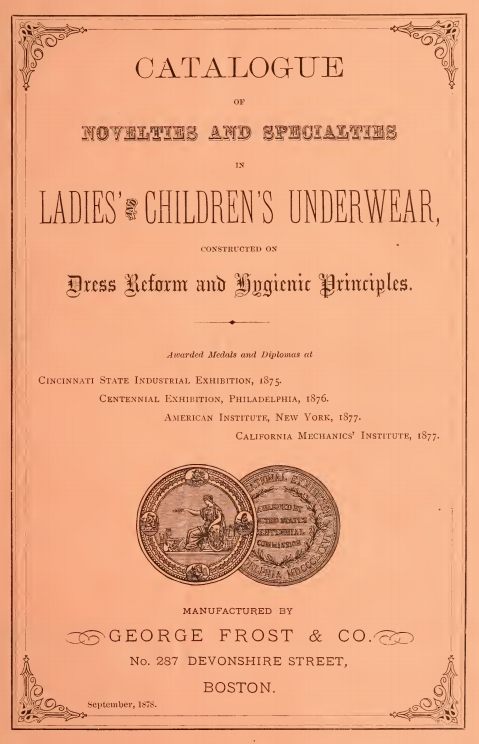
September 1878: Catalogue of Novelties and Specialties in Ladies’ and Children’s Underwear, constructed on Dress Reform and Hygienic Principles. Manufactured by George Frost & Co., 287 Devonshire Street, Boston, Massachusetts.
.
1879: B. Altman & Co. Fall and Winter Catalogue (see title page image below). [Note: this catalogue is dated 1879; B. Altman may have begun catalogue mail-order sales before this date.] Here’s a B. Altman & Co. Catalogue from 1886.
.

Title Page image of B. Altman & Co. (mail-order) Catalogue, 1879-1880 Fall and Winter.
.
1881: first known printing and distribution of the Hammacher Schlemmer catalog, selling tools and hardware. Curious? Find a reprint here.
.
1881: San Francisco Department Store Newman and Levinson also sells by mail-order.
.
.
1884: The first Eaton’s catalogue was a 34-page booklet (Toronto, Ontario, Canada).
1888: Richard Warren Sears started a business selling watches (only) through a mail order catalog.
.
1888: Sales from Montgomery Ward & Co. Catalogue reaches $1 million.
.
1891: Jordan Marsh, a fifty-year-old department store, fills mail orders from “all four quarters of the earth.” See Jordan, Marsh & Co. Illustrated Catalogue of 1891.
.
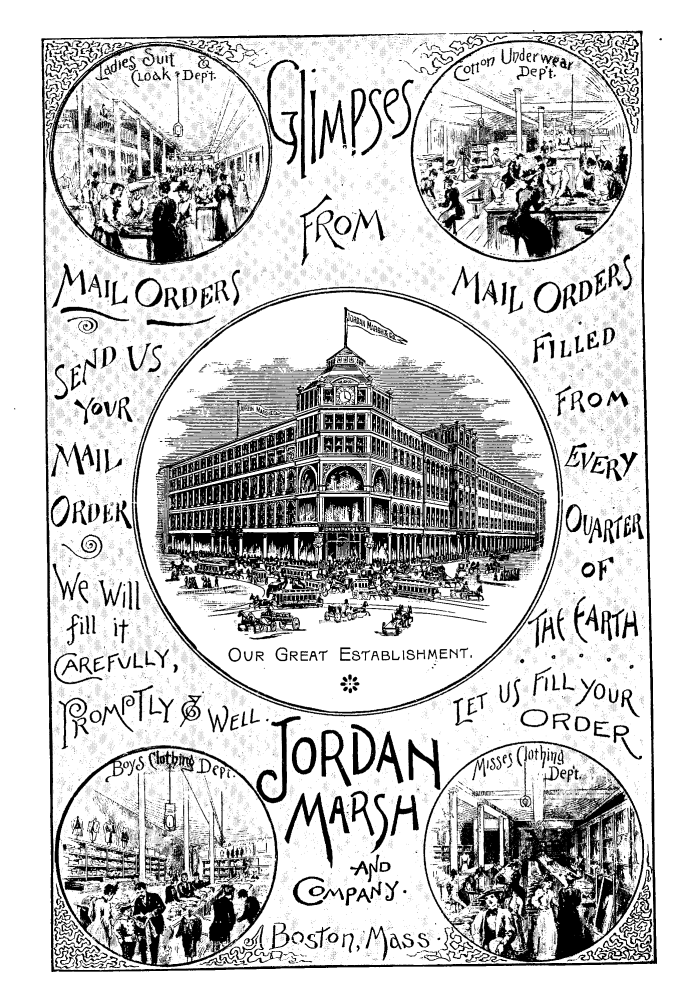
Jordan, Marsh and Co. of Boston, Massachusetts illustrates their mail-order capacities.
.
1894: The Sears Catalog expands to include a large variety of items.
.
1895: Montgomery Ward & Co. Catalogue had grown to 600+ pages.
.

.
[1963: (Yes…1963) J.C. Penney had been in the retail business since 1905 when he opened his first retail store in Kemmerer, WY, expanded his stores, and finally mailed his first mail-order catalogue in 1963.]
.
Â
.
A Wikipedia timeline of mail-order catalogs shows the vast majority began in the 20th century (1905 to 1992) and most were outside the United States.
So–why the correlation (at least in today’s fiction) of “mail-order” and lonely men in the west seeking brides from the eastern and southern states?
.

.
Q: More specifically, why aren’t Mail-Order Brides accurately refereed to as “Newspaper Brides” or “Letter Brides”?
.
A: An oddity of the development of the English Language. Just like the “Old West” became much more popular after the frontier had been swallowed up by settlement, the phenomena of “Mail-Order Brides” became more curious.
.
By then “Mail-Order” was a household term. Catalog purchases of nearly everything was a standard procedure for farmers and ranchers living in isolated areas. According to most historians, the term “Mail-Order Bride (or Mail Order Bride–no dash)” appeared in the language far later than contemporary fiction makes us believe. Who knows what, if anything, men called their pen-pals to whom they’d offered marriage…or hoped to offer marriage upon her arrival when she stepped off the train, stagecoach, or Conestoga wagon.
.
A terrific related article begins with this powerful opener:
.
“The term “mail-order bride,” as it applies to a marriage arranged via correspondence between American men and women in the Great Plains in the nineteenth century, is largely a misnomer. Twentieth-century folklore has it that a homesteader could peruse the Sears and Roebuck or Montgomery Ward catalogs and order a wife to be delivered to his dusty doorstep just as easily as he could order a rifle, stove, or stomach cure, but the truth is far more interesting. Arranged long-distance marriage existed in the Plains in a range of communities, took a number of forms, and grew out of a variety of social, economic, and cultural phenomena, but never involved the literal sale, purchase, or ownership of women, as the term “mail-order bride” suggests.”
.
.
Note: Julie’s article references three helpful books:
.
Related Articles
.
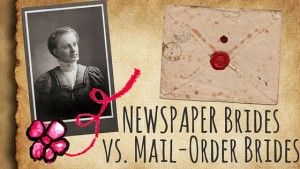 NEWSPAPER Brides vs. Mail-Order Brides, including newspaper clippings, details of the companies serving as Marriage Brokers, public opinion on the matter and so much more.
NEWSPAPER Brides vs. Mail-Order Brides, including newspaper clippings, details of the companies serving as Marriage Brokers, public opinion on the matter and so much more.
.
Titles by Kristin Holt with the Mail-Order Bride Theme:
WANTED: Midwife Bride (within A Timeless Romance Anthology #16)
.
Updated June 2021
Copyright © 2016 Kristin Holt LC
Mail-Order Catalogues Timeline and Truth Mail-Order Catalogues Timeline and Truth

